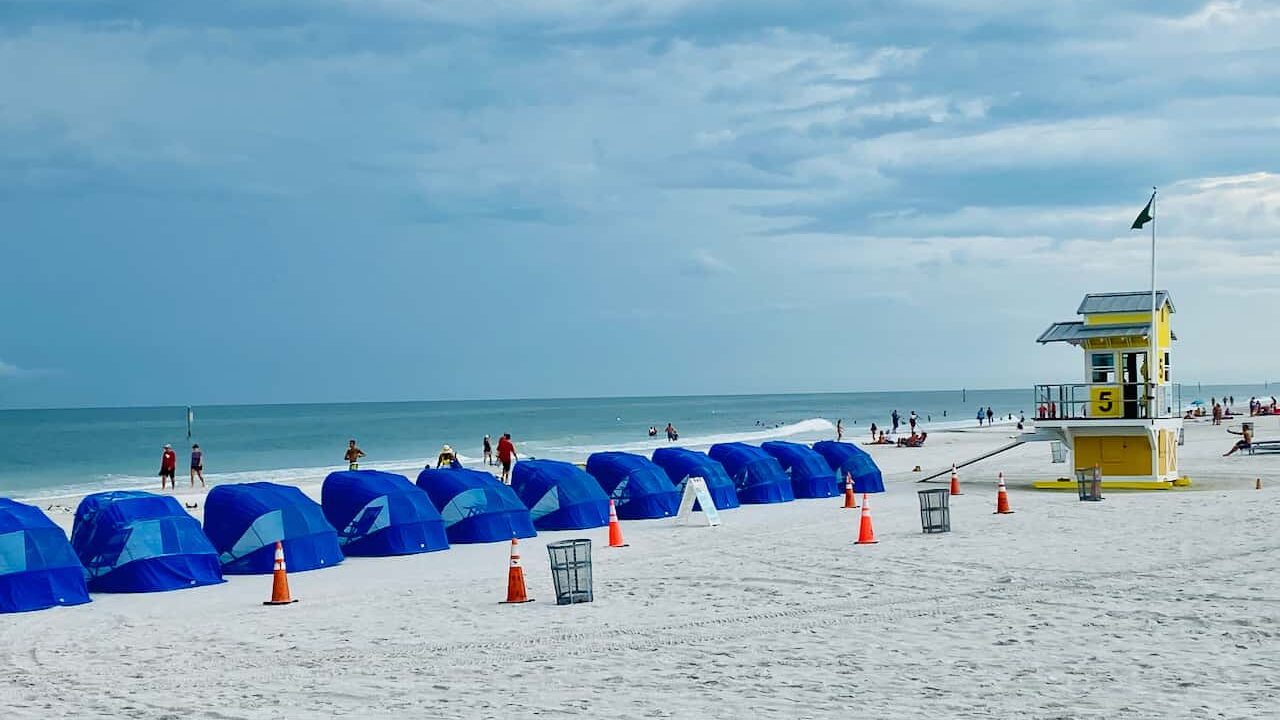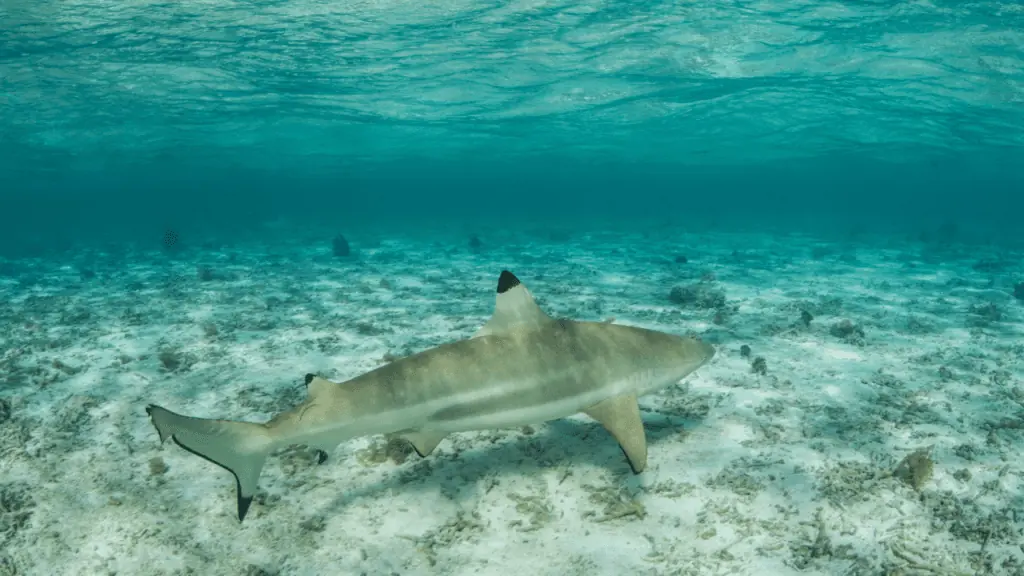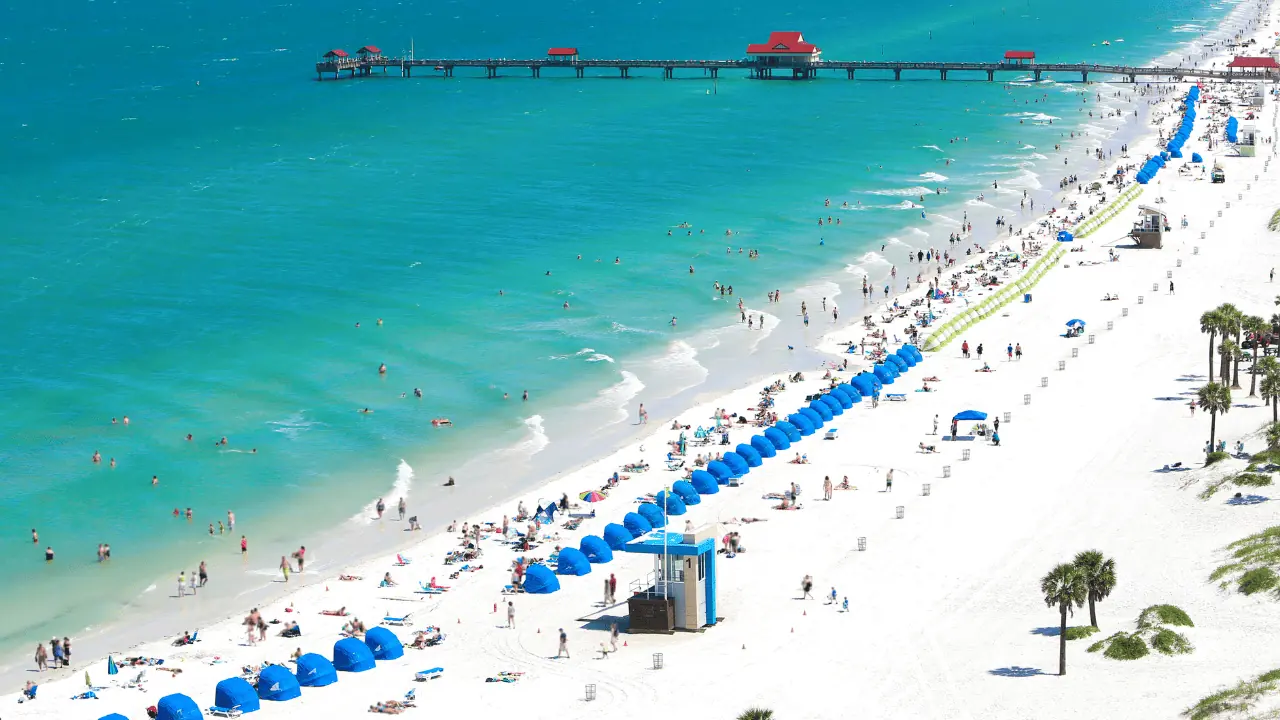Table of Contents
Clearwater Beach is one of the most beautiful places in the world for a beachfront vacation. So, one question that can come up is, “Are there sharks in Clearwater Beach?”
Clearwater Beach, located on the west coast of Florida, is a popular tourist destination known for its pristine white sand beaches and beautiful crystal clear waters. While the area is home to a diverse array of marine life, including bottlenose dolphins, sea turtles, and manatees, they are also home to a variety of sharks.
I have lived in Tampa Bay for over a decade and have lived in Florida most of my life. I’m a boater who has spent many hours on the water with my family. I can tell you I’ve never experienced any issues with sharks, keeping in mind that I followed safety guidelines.
In this article, I will cover Clearwater Beach shark attack statistics, safety suggestions, and some helpful tips so you’ll enjoy your vacation!
🌴 Read Next: Where to Stay in Clearwater Beach: 9 Amazing Vacation Hotels
Shark Attacks in Clearwater Beach
As I mentioned, I’m a local and a boater. You’ll be happy to know there aren’t many noteworthy shark attacks in Clearwater Beach. In fact, none I can think of in recent years.
However, the recommended safety advice is essential and one of the primary reasons people have avoided any impact.
Unprovoked Shark Attacks by County
One study by the University of Florida found that Florida had the most unprovoked shark bites in the United States in 2022, with 16 cases, followed by New York (8), Hawaii (5), and California (4). Florida’s Volusia County had the most shark bites, with 7 total cases.
Next, here is a breakdown of the total number of unprovoked shark attacks in Florida since 1882.
You’ll see that Clearwater Beach in Pinellas County is NOT among the top contenders. However, Volusia County has double the among of single bite shark attacks compared with Brevard County, which is the second highest.
| County | Total |
|---|---|
| Volusia | 343 |
| Brevard | 156 |
| Palm Beach | 82 |
| St. Johns | 45 |
| Duval | 46 |
| Martin | 41 |
| St. Lucie | 37 |
| Indian River | 22 |
| Monroe | 21 |
| Miami-Dade | 19 |
| Broward | 16 |
| Pinellas | 14 |
| Bay | 9 |
| Collier | 8 |
| Lee | 8 |
| Sarasota | 7 |
| Flagler | 6 |
| Escambia | 6 |
| Nassau | 8 |
| Okaloosa | 4 |
| Manatee | 5 |
| Gulf | 2 |
| Franklin | 2 |
| Walton | 1 |
| Charlotte | 1 |
| Santa Rosa | 1 |
This study also found that unprovoked shark attacks tend to be less common in the early morning, evening, and night hours. The worst time of day is around 2 to 3 pm. However, this may stem from fewer people in the water.
Shark Attacks in Clearwater Beach in 2033
Over the last few years, no recent shark attacks have been reported in Clearwater Beach. While they have been spotted on occasion near the shoreline, no one was affected. Since Florida has had the most shark attacks in the world, it’s essential to keep that statistics do not equal future results.
Shark Species Found In Clearwater Beach Waters
When it comes to beach vacations, safety is always a priority. So, if you’re planning a trip to Clearwater Beach, you may be wondering about the presence of sharks in the area. The good news is that there are a few species of sharks that have been spotted from time to time, but the risk of an encounter is relatively low.
So, let’s take a deeper dive (no pun intended) into what you need to know about sharks in Clearwater Beach.
From my experience, the most common sharks that can be found in the waters around Clearwater Beach include the following:
- Blacktip Sharks
- Hammerhead Sharks
- Nurse Sharks
- Lemon Sharks
Black Tip Sharks
Blacktip sharks are the most common types of shark found in the waters around Clearwater Beach. These sharks are typically found in shallow waters near the beach, especially when young. The blacktip is often considered the common source of unprovoked bites.
The blacktip shark can grow up to 8 feet long, but usually average around 5 to 6 feet. Here are some distinguishing features of the blacktip shark’s appearance:
- The blacktip shark has a streamlined body shape with a pointed snout and large, oval-shaped eyes.
- The shark’s body is typically bluish-gray in color.
- As its name suggests, the blacktip shark has black tips on most of the fins, which are especially visible when the shark is swimming close to the surface of the water.
Overall, the blacktip shark is a sleek and agile predator that is well-adapted to hunting in its ocean environment. It also tends to be one of the most common sharks hooked by fisherman.
Nurse Shark
Nurse sharks have a catfish resemblance that is known for usually being harmless to humans. They are slower-moving sharks that tend to spend most of their time in warm, shallow waters. As they age, their sizes range from 7 to 9 feet in length. I tend to see nurse sharks more frequently when paddleboarding in less populated areas offshore.
Hammerhead Sharks
There are several species of hammerhead sharks. The bonnethead shark is one of the most common in Clearwater Beach or Pinellas County. It averages about 3 to 4 feet long and has a shovel-shaped head. Bonnethead sharks are commonly seen in shallow bay water or estuaries and tend to be considered harmless to humans.
Scalloped hammerhead shark is another common variety in Florida. It has a noteworthy flathead appearance. It is often seen around 5 feet in size, but can grow considerably larger. It is often confused for the great hammerhead shark. The scalloped hammerhead has a straight backside of the head, while the great hammerhead has a curved backside. Great hammerhead sharks tend to be seen more in South Florida and can get as big as 20 feet! They tend to be much less common.
Lemon Shark
The lemon shark is a yellow-gray colored shark that tends to prefer spending time in shallow waters. It averages about 4 to 7 feet in length but can get as big as 11 feet. While these sharks can be laid-back, lemon sharks can act upon bursts of energy and aggression especially when provoked.
In addition to the above shark populations, other most common shark species in the Gulf of Mexico include the tiger shark, sandbar shark, and blacknose shark near Clearwater Florida. However, these species rarely come close enough to shore for beachgoers to worry about an encounter with them. A variety of sharks can be present in the area, so its best practice to follow safe swimming guidelines at all times.
Can you Swim in Clearwater Beach?
Clearwater Beach is one of the most beautiful places in Florida to go for a swim in the Gulf of Mexico. Its crystal clear water and white sand beaches make it an ultimate vacation getaway. If you’re like me, you’ll want to move here (which I did)!
Besides the clear water beaches, it’s got great year-round weather with lifeguards on duty. For this reason, families love Clearwater Beach and Pier 60, with a park, playground, pavilions, pier fishing, and more! So when you get tired of swimming you’ll have enough family-friendly activities for days.
General Safety Advice For Swimmers
Fortunately, there are some simple steps that you can take to ensure your safety when swimming in Clearwater Beach. Even though the risk of a shark attack is low, following precautions minimize the risk to beachgoers.
To start, pay close attention to local advisory warnings. These updates can provide valuable information about potential hazards such as dangerous weather conditions or sightings of large predators like sharks.
The latest weather conditions and warnings can be found on the Pinellas County map. This includes information on red tide or other severe weather alerts.
Clearwater Beach Flag Warnings
Clearwater Beach as well as most Florida beaches utilize a flag warning signal to beachgoers. When at the beach, you’ll want to keep an eye out for these flags and their appropriate meanings.
- Green: Calm, low risk water conditions
- Yellow: Medium conditions with moderate currents or surf
- Red: High conditions that can be hazardous with strong currents
- Double Red: Water is not open to the public
- Blue: Dangerous or stinging marine life seen in the water
Lifeguards on Duty
Clearwater Beach is one of the few beaches in the area that offer lifeguards on duty. This added precaution helps families have an extra layer of support when enjoying the Gulf of Mexico.
Lifeguard Towers are staffed year-round from 9:30 am to 5 pm. Hours can fluctuate based on the season, so you’ll want to refer to the Clearwater Beach rules.
10 Important Tips to Avoid Sharks Clearwater Beach
To start, there are two types of shark attacks which are provoked or unprovoked bites. Provoked bites include touching, feeding, or harassing them. I have found this more common with adolescents who are tend to be naive about the potential consequences.
Unprovoked bites are precisely what it means, you had no intention of interacting with a shark, and usually occur in low visibility conditions. These usually involve sneak bites, hit-and-run-bites, and bump-and-bites. For beachgoers, the hit-and-run bites are what tends to occur, where the shark can make one grab at a person, lets go, and immediately leaves.
Here is a summary of tips to avoid shark attacks:
- Follow the beach flag warning signals, and do not enter when there is a blue flag (shark or other potential hazard).
- Always swim with a companion or group. Sharks are more likely to go after one person versus two or more humans.
- Stay close to the shoreline. The further you get out in the Gulf of Mexico, the harder it is for lifeguards to assist you timely.
- Sandbars tend to be a favorite location for sharks to hang out. Be cautious, as there may be also drop-offs that affect your visibility or balance.
- Skip swimming in the early morning or evening to night hours. You’re most at risk when sharks tend to be feeding. It also affects your visibility when the lighting isn’t optimal.
- If you’re bleeding, it’s best to avoid swimming in water that may or may not attract a shark.
- Leaving shiny jewelry behind is recommended, as it may attract attention similar to fish scales.
- Avoid feeding areas where people may be feeding fish or fisherman areas, which could draw in a shark.
- Swim in clear water, and skip murky water where you can’t see the bottom.
- Refrain from splashing around a lot where it appears you are in distress (and potential prey).
To further reduce the risk of shark attacks, beach authorities and lifeguards in Clearwater Beach take a number of precautions. These include monitoring the water for signs of shark activity, posting warning signs when sharks are present, and using drones to spot sharks in the water. In addition, lifeguards are trained in shark recognition and are prepared to act quickly in the event of a shark sighting.
Final Thoughts | Are There Sharks in Clearwater Beach?
Hopefully, I have answered your question: Are there Sharks in Clearwater Beach?
While there are sharks in Clearwater Beach, the risk of a shark attack is relatively low. By following local safety guidelines and exercising caution while swimming, visitors to Clearwater Beach can enjoy its beautiful waters.
If you’re planning your dream beach vacation in Clearwater Beach, you’ll want to check out my favorite hotels and things to do next!
Frequently Asked Questions
Are there sharks near Tampa?
There are sharks in the waters around Tampa, Florida. The Gulf of Mexico, which Tampa is located on, is home to a variety of shark species including bull sharks, blacktip sharks, hammerhead sharks, and tiger sharks. While shark attacks tend to be rare, it’s always a good idea to take appropriate safety precautions as recommended by local authorities or lifeguards.
Are there sharks around Clearwater Beach?
Clearwater Beach is home to a variety of shark species including blacktip sharks, nurse sharks, lemon sharks, among others. If you plan to swim or surf in the waters around Clearwater Beach, it’s always a good idea to take appropriate safety precautions.
Does Clearwater have a lot of sharks?
Clearwater tends to be a very active beach and highly populated. Sharks tend to prefer attacking when a person is isolated.
Clearwater shark attacks are very rare, considering about 14.9 million visitors come to Clearwater or St Petersburg annually, and since 1882, there has been a total of 14 shark attacks in Pinellas County.
Which coast of Florida has more sharks?
Volusia County (Daytona Beach / New Smyrna Beach area) on the east coast has the most unprovoked shark attacks. It has had a total of 343 since 1882, which is why it gained the title of “shark bite capital of the world.”




